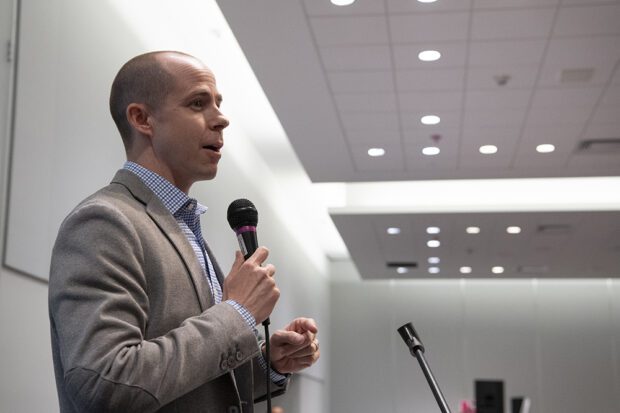
“Where are the Democrats?” Everyone seems to be asking this question—from pundits such as Ralph Nader and Robert Reich to grassroots activists.
Nader called Trump’s March presidential address to Congress “a declaration of war against the American people, including Trump voters, in favor of the super-rich and the giant corporations.” Yet, what has been the Democratic response?
The high-profile tour of Senator Bernie Sanders (I–Vt.) and Rep. Alexandria Ocasio-Cortez (D–N.Y.) has drawn large crowds throughout the country, including last month in Bakersfield. Despite the huge appetite among activists for engagement, the Democratic Party’s leadership at every level seems reluctant to be at the forefront of the resistance to the Trump administration.
“I will admit I think the general response overall has been slower than many would have hoped,” says Rusty Hicks, chair of the California Democratic Party.
“I think there’s two schools…within Democratic circles: The first is you get to the plate and swing at every pitch. That’s the [U.S. Senator] Chris Murphy (D‒Conn.) view of the world.
“And then you’ve got the [House Minority Leader] Hakeem Jeffries (D‒N.Y.) view of the world, which is you get up to bat and pick your pitches, but you can’t swing at everything. You’ve got to be strategic about what you engage with at this particular moment.
“I think I am probably more on the side of being strategic about how you engage.”
“It’s always interesting to figure out who people mean by ‘the party’ when they’re complaining or making suggestions about what the Democrats should do,” notes Daraka Larimore Hall, lecturer at UC Santa Barbara in labor studies and a former vice chair of the California Democratic Party.
“The ‘Democratic Party’ is a really diverse, diffuse, decentralized set of institutions and groups. It’s not like a very unified thing to begin with.
“There is a lot of desire out there, demand really, for a more unified message and more visibility from people that are identified with the Democratic Party, more visibility on their part, either actively resisting, slowing down or stopping Trump’s agenda or mobilizing people, engaging people for an alternative to take to the ballot in future elections.
“When people are like, ‘I want to see the Democrats out doing something,’ they often mean different things, but right now I think people aren’t seeing enough of either of those.
Nader also notes that “we’re dealing with a deranged, unstable pathological liar, who’s getting away with it” and asks how he gets away with it. His response: “Because the Democratic Party has basically collapsed.
“The more important problem is how the party of FDR is not winning huge majorities of union members, working families and how are those voters falling for the lies of a fascist buffoon.”
—Daraka Larimore-Hall
Looking Back
To paraphrase David Byrne of the Talking Heads, “How did we get here?”
Looking back at the 2024 election, Hicks says that “here in California, where we showed up, we won.
“If you look at the turnout difference, the electoral outcome difference, between those areas where there was targeted, dedicated, year-round organizing and infrastructure in place, primarily around the Congressional seats, we saw us able to cut in half swings that you might have seen in significant numbers in other parts of the state.
“And we were able to eke out a win in six of eight targeted battleground Congressional seats. In most sports, winning six of eight will get you in the Hall of Fame.
“It was a lot of things,” explains Larimore-Hall. “One is that there is a longer-scale process in which the Democratic Party has lost support among working Americans, and that has ebbed and flowed, it slowed and sped up, but it’s been a consistent trend since the 70s. And we never have really reckoned with the major reasons for that.
“That’s a process that has accelerated since the 90s. The party really abandoned its historical commitment to putting workers first in the economy.
“We can focus on things that the Harris campaign should have done better given the very short time frame that they had, but, for me, the more important problem is how the party of FDR is not winning huge majorities of union members, working families and how are those voters falling for the lies of a fascist buffoon.”
Looking Ahead
“We have to be strategic and focused on how we can change the Democratic Party effectively rather than just complaining about it,” intones Larimore-Hall. “But there’s no reason to pretend that we don’t have a real crisis in leadership.
He posits that Jeffries and Senate Minority Leader Chuck Schumer (D‒N.Y.) should be replaced. “They’re just not at all equipped for this moment.”
“What we need is to be able to provide working-class voters with a real alternative that is meaningful for their lives that is aimed at improving their economic well-being and to be bold about those things,” adds Larimore-Hall. “That’s the solution.
“We don’t have to roll back our commitment to civil rights, human rights and social progress to make that case.”
Hicks lays out a different strategy: “You’ve got to legislate; you’ve got to litigate; continue to push back on the overreach of the White House, and you’ve seen [Attorney General] Rob Bonta do that; and lastly, you’ve got to organize—really to help make voters and the public aware of what these actions mean and their impact to their everyday lives and to be in position for when public sentiment changes.”
Heading into its convention in late May, Hicks says that the state party is “still in kind of a preparation phase, knowing that this is a two-year fight” adding that “it’s our job to use the organizing infrastructure we have to remind people as to what their member of Congress is doing.”
Larimore-Hall stresses the need to continue the work on “reforming the structures of the party and finding ways to truly empower activists and grassroots stakeholders in the party.
“We have to show up; we can’t walk away. That sounds trite, but it’s really true. In times like these, it’s very easy to get demoralized.”
The importance of engaging players outside the party was also noted. “The party is just a gathering place for activists to come together to make political change,” says Larimore-Hall. “The resistance has to be led by ordinary people regardless of the hat that they’re wearing.
“The politicians are definitely not the ones who are going to do that. It’s going to be ordinary people taking time, developing leadership skills, taking risks even, to move American politics back to a pro-worker, environmentally sane kind of project.
“The party can’t be afraid of being part of the movement pressure on Democratic elected officials. That doesn’t mean you can’t be friendly, or have a good relationship or whatever, but our Democratic officials should take for granted that the Democrats will be on their asses to make sure that people have [for example] clean drinking water.
“They should never, ever expect that the party would give them cover to not do it or to do something bad.”
The California Democratic Party will hold its 2025 state convention on May 30‒June 1 in Anaheim. Any Democrat can attend as an observer (cdpconvention.org/register/). Elections will be held for the state party officers and regional directors. Make your voice heard.

